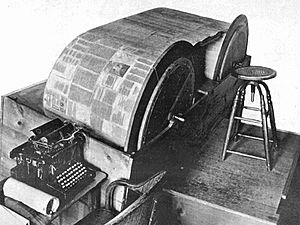Orville Ward Owen facts for kids
Dr. Orville Ward Owen (born January 1, 1854 – died March 31, 1924) was an American doctor. He was a strong supporter of the Baconian theory. This theory suggests that Francis Bacon actually wrote the plays usually credited to William Shakespeare. Owen believed he found secret messages hidden in these famous works. He used a special tool he invented called a "cipher wheel" to uncover these messages. His findings were published in a large book series titled Sir Francis Bacon's Cipher Story (1893–1895).
Owen's Cipher Wheel Method
Owen's "cipher wheel" was a unique machine. It helped him quickly sort through pages from plays and writings by Shakespeare, Francis Bacon, and other writers of that time. The goal was to find parts that seemed connected by certain words or phrases. Owen called this his word cipher method. He used a very long canvas strip, about a thousand feet long. On this strip, he pasted all the works of Shakespeare, along with writings from Christopher Marlowe and other authors. When the wheels turned, specific keywords would light up.
Experts in codes, William and Elizebeth Friedman, looked closely at Owen's method. They concluded that it was not a real way to decode secret messages. Also, a friend of Owen's, Dr. Frederick Mann, wrote a strong criticism of the method. Mann pointed out that Owen's approach meant that amazing plays like Hamlet and Romeo and Juliet were not the main works of a genius writer. Instead, they were just tools Bacon used to hide his secret codes. Mann also noted that Owen and his helpers often changed passages. They did this even when the secret code was supposed to be found by keywords. Sometimes, the keyword was very far from the text they used.
Owen believed that Francis Bacon wrote many works credited to other authors. These included works by Shakespeare, Robert Greene, George Peele, Edmund Spenser, and Robert Burton.
Owen's Secret Discoveries
Owen's book, Sir Francis Bacon's Cipher Story, shared some surprising claims. It stated that Queen Elizabeth I was secretly married to Robert Dudley, Earl of Leicester. According to Owen, they had two sons: Francis Bacon and Robert Devereux, 2nd Earl of Essex. Owen claimed that Queen Elizabeth I later had her son, Robert Devereux, executed. This idea became known as the Prince Tudor theory. Owen believed Bacon had hidden this secret history of the Elizabethan era in his own writings and in the many other works he supposedly wrote under different names. Bacon's hidden messages were said to be in blank verse, like a question-and-answer session. A voice would ask Bacon questions, and he would give long verse replies.
Owen's findings also suggested that when Queen Elizabeth discovered Bacon had written Hamlet, she limited his freedom. This supposedly forced him to hide his best work using masks and codes. These codes, Owen claimed, were only meant to be found three hundred years later. Owen also stated that Bacon himself uncovered his brother's plan against the queen. Another claim was that Romeo and Juliet was actually the story of Bacon's love with the Queen of France, Margaret of Valois. Owen even claimed that Queen Elizabeth confessed Bacon was her son on her deathbed. However, he said she died under suspicious circumstances, possibly to stop her from naming Bacon as her successor. Owen also claimed to have found two new plays written by Bacon. These were The tragical historie of our late brother Robert, earl of Essex and The historical tragedy of Mary queen of Scots.
Owen became convinced that original manuscripts were hidden in iron boxes. He believed these boxes were buried near the River Wye at Chepstow Castle. In September 1909, he searched caves near the castle without success. The next year, he returned and dug in the riverbed. He thought a deep crack in the riverbed held a secret vault with 66 lead-lined boxes. His search gained a lot of attention from the media. Many workers were hired to dig out mud and support the digging area. Owen did not find any vault or boxes. However, he did discover the remains of a Roman bridge near the castle. He also found a medieval water cistern that no one knew about before.
Owen passed away as a "bedridden, almost penniless invalid." He regretted sacrificing his career, reputation, and health for the "Baconian controversy." He warned others to learn from his experience and avoid similar pursuits. His ideas were later continued by his assistant, Elizabeth Wells Gallup.
Owen's cipher wheel was found in a warehouse in Detroit by Virginia Fellows. She was a supporter of Owen's theory in the 20th century. She gave the wheel to her publisher. Her book, The Shakespeare Code, was published in 2006, shortly after she died.
Images for kids





